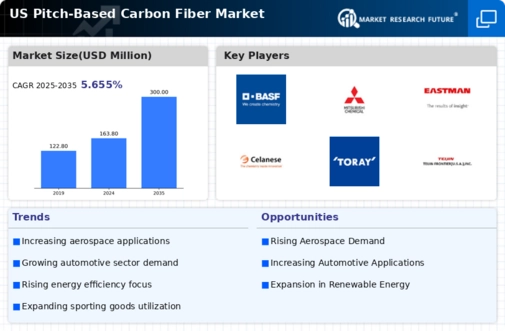The pitch based carbon fiber market is currently characterized by a dynamic competitive landscape, driven by increasing demand across various sectors such as aerospace, automotive, and renewable energy. Key players are actively pursuing strategies that emphasize innovation, sustainability, and operational efficiency. For instance, Toray Industries (Japan) has positioned itself as a leader through continuous investment in R&D, focusing on high-performance materials that cater to the evolving needs of its clients. Similarly, SGL Carbon (Germany) has adopted a strategy centered on expanding its production capabilities, particularly in the U.S., to meet the growing demand for lightweight materials in the automotive sector. These strategic initiatives collectively enhance the competitive environment, fostering a climate of innovation and responsiveness to market needs.
In terms of business tactics, companies are increasingly localizing manufacturing to reduce lead times and enhance supply chain resilience. This approach appears to be particularly effective in a moderately fragmented market, where the collective influence of key players like Mitsubishi Chemical (Japan) and Hexcel Corporation (U.S.) is notable. By optimizing their supply chains and establishing regional production facilities, these companies are better positioned to respond to fluctuations in demand and mitigate risks associated with global supply chain disruptions.
In November 2025, Mitsubishi Chemical (Japan) announced a strategic partnership with a leading aerospace manufacturer to develop advanced pitch based carbon fiber composites. This collaboration is expected to leverage both companies' expertise, potentially leading to innovative applications in aircraft design and construction. The strategic importance of this partnership lies in its potential to enhance product offerings and solidify Mitsubishi's position in the aerospace sector, which is increasingly focused on lightweight materials to improve fuel efficiency.
In October 2025, Hexcel Corporation (U.S.) unveiled a new production facility dedicated to pitch based carbon fiber in the Midwest. This facility is anticipated to significantly increase Hexcel's production capacity, allowing the company to better serve its growing customer base in the automotive and aerospace industries. The establishment of this facility underscores Hexcel's commitment to meeting market demand and enhancing its competitive edge through localized production.
Furthermore, in September 2025, SGL Carbon (Germany) launched a new line of sustainable pitch based carbon fibers, which are produced using eco-friendly processes. This initiative not only aligns with global sustainability trends but also positions SGL as a forward-thinking player in the market. The introduction of these sustainable products is likely to attract environmentally conscious customers and enhance SGL's market share.
As of December 2025, the competitive trends in the pitch based carbon fiber market are increasingly defined by digitalization, sustainability, and the integration of advanced technologies such as AI. Strategic alliances are becoming more prevalent, as companies recognize the value of collaboration in driving innovation and enhancing product offerings. Looking ahead, it is anticipated that competitive differentiation will evolve, shifting from traditional price-based competition to a focus on innovation, technological advancements, and supply chain reliability. This transition may redefine the competitive landscape, compelling companies to invest in R&D and sustainable practices to maintain their market positions.
























Leave a Comment